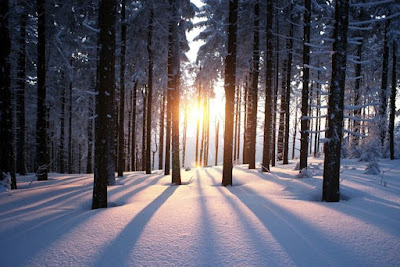What Makes the 2018 Winter Solstice Special?
 Winter solstice takes place Friday December 21, 2018 at
5:23pm. This marks the beginning of astronomical winter and is the day of
shortest sunlight. I enjoy the optimism of days lengthening and darkness
shortening following the solstice. If you are wearing a warm coat and mittens
today, and you can remember sunny picnics enjoyed on summer beaches, then you
know some things about seasons.
Winter solstice takes place Friday December 21, 2018 at
5:23pm. This marks the beginning of astronomical winter and is the day of
shortest sunlight. I enjoy the optimism of days lengthening and darkness
shortening following the solstice. If you are wearing a warm coat and mittens
today, and you can remember sunny picnics enjoyed on summer beaches, then you
know some things about seasons.
All planets in our solar system orbit the sun. Our earth
takes 365.25 days to travel around the sun, which is one year. While earth
makes this journey, it also rotates around its axis, which takes 24 hours. That
is our day length. Earth does not have a perfect, straight up and down axis,
earth sits at a tilt of 23.5 degrees. This tilted axis is what causes our
seasons.
In December and January, the earth is closer to the sun than
it is in July and August, but because of the axis tilt, North America is facing
away from the sun during our winter months. During summer, North America tilts
toward the sun.
The longer darkness this time of year invites snuggling
under warm blankets, and thoughtful reflection. This is a nice time to spend
with family, friends, favorite books, and warm drinks to reconnect, share
memories from 2018, and plan for 2019.
This year the solstice lands on the rise of a full moon. The
Abenaki call this the Pebonkas, or “Winter Moon.” Other native tribes call it
“Full Cold Moon” and “Long Nights Moon.” This is a very rare occurrence that
will not be seen again until 2094. Our
solar year is made up of 13 moons, and the next moon in January is called
Anhaldamawikizos or “Forgiveness Moon” by the Abenaki. This fits well with the
optimism of looking forward to more light in our days.
With the solstice, the sun has reached its southern most
position in our North American sky. People living on the equator do not
experience the changing seasons, they receive the same amount of sunlight all
year long. The further you live from the equator, the more extreme the seasons become.
In Barrow, Alaska, the northernmost city in the US, they experience four months
of total sunlight from May to August, and complete darkness from November
through January.
In Vermont we experience the seasons in exactly the right
quantity. We get the beautiful warm summer days, cool crisp autumns, winters
made to play outside in the snow, and beautiful springtime when we watch
greenery appear out of the mud. Celebrate the solstice in the way you enjoy
most, and make room in your lengthening days for some outdoor adventures in
your favorite state parks.
Rebecca Roy
Conservation Education Coordinator


.jpg)
.jpg)
Comments
Post a Comment
Feel free to let us know what you think.